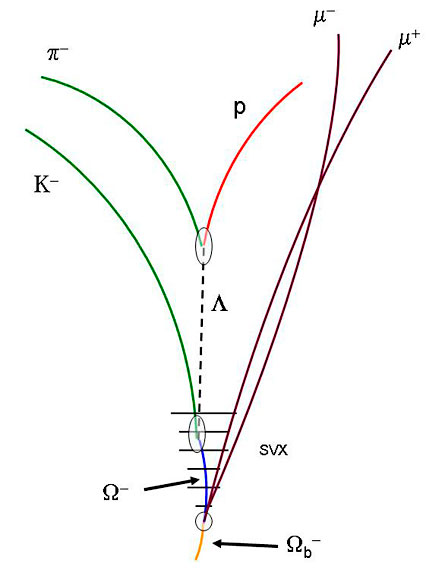- More than 2 years ago
A heavy, strange cousin of the proton has been seen a second time, but it seems to have lost a little weight. The omega-b-minus, also called the omega-sub-b baryon, is a three-quark particle related to protons and neutrons. It has been observed at the Collider Detector at the Fermi National Accelerator Laboratory in Illinois, scientists announced in a paper submitted to Physical Review D and available online at arxiv.org. But CDF’s measurement of the particle’s mass is significantly lower than a previous measurement, leaving researchers wondering what caused the discrepancy.

“One or both of the measurements are missing the mark,” says CDF physicist Pat Lukens, a coauthor of the paper.
DZero, CDF’s sister detector, had observed the omega-b-minus in fall 2008 using the same proton accelerator, the Tevatron, at Fermilab (SN: 9/27/08, p. 9). Although CDF’s recent mass measurement of 6.054 billion electronvolts agrees better with the expected mass for an omega-b-minus particle than DZero’s measurement of 6.165 billion electronvolts, the mismatch in the results is disconcerting, the researchers say.
“We don’t have an explanation,” says Darien Wood of Northeastern University in Boston, cospokesman for DZero. “We checked for obvious errors, and we haven’t found any.” Wood says such discrepancies come up from time to time in experimental physics, and additional data could resolve this one.
The standard model of particle physics predicts the existence and mass of this particle, which is a baryon like protons and neutrons. Protons contain two up quarks, which each have an elementary charge of +2/3, and one down quark, with a charge of -1/3. The omega-b-minus, on the other hand, has two strange quarks, both -1/3, and a bottom quark, also -1/3. Strange quarks and bottom quarks are heavier than up and down quarks, making omega-b-minus six times as massive as a proton.
This massiveness means omega-b-minus is unstable — just over a trillionth of a second after its creation in the high-energy collision at the Tevatron, the particle ceases to exist, the researchers observed. But it does leave behind a telltale pattern of smaller, more stable particles. Omega-b-minus is also produced rarely: CDF scientists detected it only 16 times out of about half a quadrillion collisions.
The elusive particle may not be seen often, but it is playing a supporting role in a grander enterprise, says Fermilab theorist Andreas Kronfeld. “If the standard model were a movie, you wouldn’t get Robert De Niro to play the omega-b baryon,” Kronfeld says. But understanding the properties of each possible combination of quarks helps scientists answer larger questions, such as why the universe is made mostly of matter instead of antimatter.
Wood says he believes the two teams’ detections are probably the same particle since DZero found no particles at the CDF mass and vice versa.
“If we hypothesize that they are two different particles, we would still have to explain why each experiment does not see the one that the other sees,” comments Wood.







